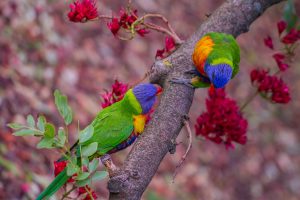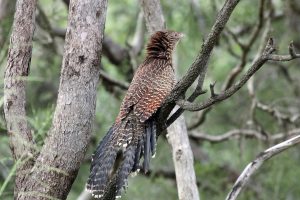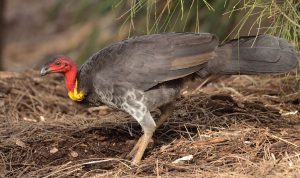
The dawn choruses and dazzling plumage of the local bird population are a source of comfort and joy – though their own lives can seem like a battle at times, writes Digby Hildreth.
There’s a blue-faced honeyeater out on the veranda right now, looking very disgruntled after a night of rain, its feathers wet and ruffled – cranky about having to compete with the mob of noisy miners.
They are just two of perhaps a dozen species who visit this modest-sized garden. It’s a small sample of the 120 species that Byron Bird Buddies’ Jan Olley says have been observed in Bangalow, yet they bring infinite delight with their antics, athleticism, distinctive personalities and flashes of colour – and of course, their singing, not always melodic but providing the entrancing soundtrack of our dawns and dusks.
Their presence brings a sense of wonder, and hope in these fearful Covid days, a vivid affirmation of the life force.
My most exciting visitor was a pheasant coucal; the strangest a white-faced heron, its stalking a miracle of concentration. An elegant heron also frequents a neighbour’s place, lured by the goldfish in his pond. Its presence sends the fish into hiding under plants, sometimes for months.

But it is native flora that proves the greatest drawcard.
Sue Franklin reports an influx of rosellas and lorikeets into her garden since planting natives. “I even had a regent bowerbird here once,” she says. “That was very special.”
It doesn’t take much, as Milton Cater found on his rural property: planting a smallish patch of grevilleas and other natives led to the arrival of hordes of the blue-faced Honeyeater and, to his great delight, the grey fantail.
His neighbour Christobel Munson’s property, rich in natives, boasts an extraordinary range of birdlife: black and pink cockatoos, goshawks, kookaburras, magpies, currawongs and pied currawongs, kestrels, willy wagtails, crows, eagles, honeyeaters and several varieties of finch – “some with little red heads, some with a red flash on their backs. And heaps more – but I don’t know their names!” she says.
On farmland planted with koala habitat on the western side of town, “an elusive cat bird, with its distinctive call and its darting and flashes of luminous green” is artist Hilary Herrmann’s current favourite – despite its venturing into her kitchen to steal fruit. “It’s quite partial to pears,” she notes.
On the same property, the friarbirds are out in force, making a racket, with Hilary uncertain whether they are mating or feeding off the silky oaks, “which are in gorgeous golden flower at the moment”.
She also sees an abundance of pigeons, magpies, currawongs, peewees, willy wagtails, crows, rozellas, king parrots and the splendidly named spangled drongo – all enticed by a bird bath full of native seeds and fruit.
The area’s great variety of birds can best be appreciated by a visit to one of the remnants of native bush on our doorstep – at Booyong or, even closer, amid the gloriously restored Byron Parklands.
There, the Byron Creek Walk provides opportunities to see herons, the white-headed pigeon, the striated pardalote, and dozens more species.
Arakwal custodian Delta Kay conducts Parklands explorations, enjoying and explaining the plants and creatures for their totemic significance and as guides to living sustainable lives. She loves watching tiny wrens skimming along in front of her groups of walkers, and hearing the crack of the whipbird, the harsh cries of the white cockatoo – or “gehr” in Bundjalung language – and the “car alarm” sound of the wompoo pigeon.
Back home – and the noisy miners are at it again, larrikins living up to their name: vocal and bolshy, seeing off any “outsiders”, the UAP-yellow beak and patch behind the eyes doing them no favours.They are members of a huge family whose name befits a sensualist rock band or Dionysian cult – the honeyeaters. Spotted frequently in Bangalow backyards is the blue-faced variety, prettier than its noisy cousin but scarcely better behaved.
Birds’ cycles are complicated and nuanced – their whys and wherefores a mystery to the lay observer. A lot of species are migratory, including the nine or so varieties of cuckoo that are returning to the region now, from Indonesia or Solomon Islands.
Possum Creek resident Jo Immig, who lives surrounded by rainforest, says she was surprised to discover that the cooler months are more intense, ushering in “the arrival of large flocks of white-headed rainforest pigeons feasting in the lowlands. They love camphor berries and like to gather high in the treetops filling the airwaves with melodic chatter. Even the collective whoosh of wings as they take off, and their ominous sudden silences, are sounds I love to hear”.
Back in town, for a time during the last weeks of winter, it was the crows, high up in a vast conifer next door, that dominated the landscape with their loud, accusatory calls. The mournful descending cry that completes their song cycle stirs empathy, makes the raucousness forgiveable.
The crows moved on, or at least fell silent – nothing could maintain that level of outrage – to be replaced in September with nesting magpies, who brought a new and bewildering level of aggression, threatening the hand that had fed them and terrorising even the most blameless of moggies. Come October, they were all sweetness and light again, perched outside, quardle-oodling for a snack.
The conifer is like an apartment block for birds, tenants coming and going: at one point of the year it is home to the much-reviled “bin chicken” – the ibis, who flock there at dusk, landing awkwardly and providing talkative white dots coloured pink by the setting sun.

Even these can be fascinating: shunned like the unlovely brush turkeys that appear and destroy our gardens with supreme indifference, they are elegant in flight, and offer a glimpse into the prehistoric.
The brush turkey belongs to a family that dates back 30 million years and whose egg incubation process is an extraordinarily primitive nesting behaviour, closer to a crocodile than a normal bird’s.
The newly hatched turkey chick, abandoned in a mound of compost the size of a Beetle, spends the first two days of its life scrambling up through a metre of dirt and detritus to reach the surface, where it has to fend for itself.
Now that demands respect. The turkeys deserve respect for other reasons too, says Jo Immig. “They wear the indigenous flag and remind us that we are just visitors. They are my greatest teacher: don’t get attached to your garden.”